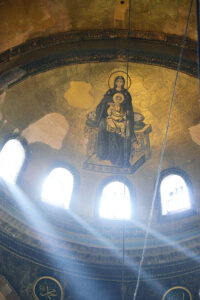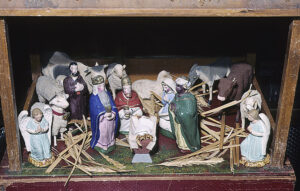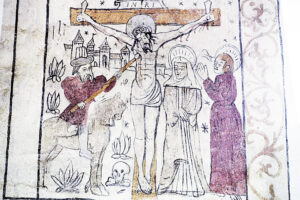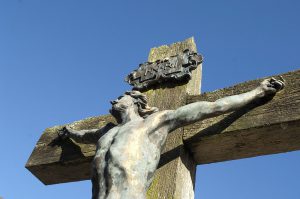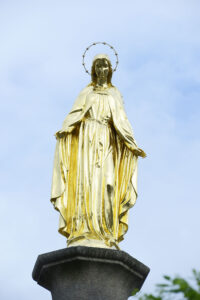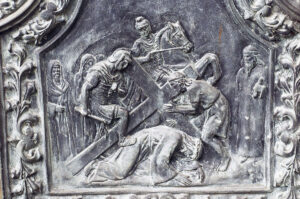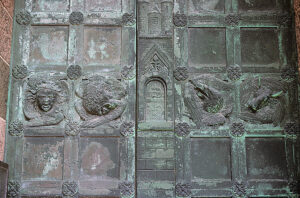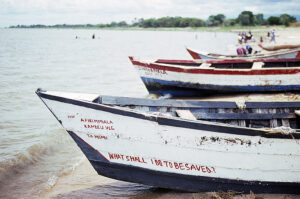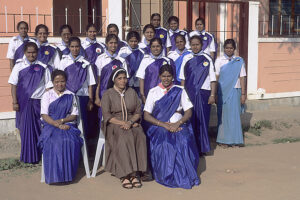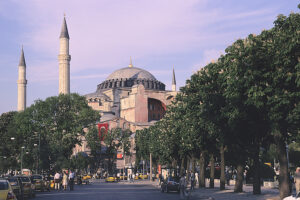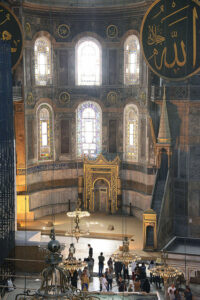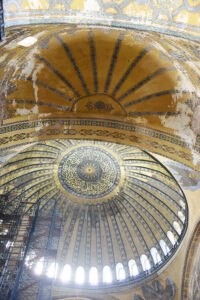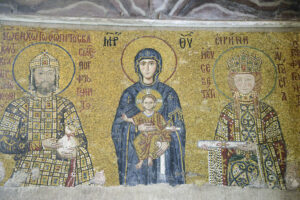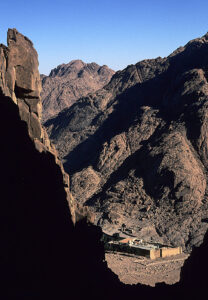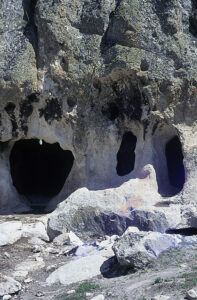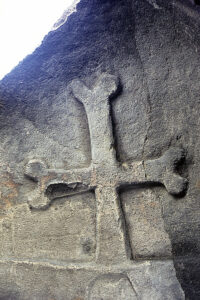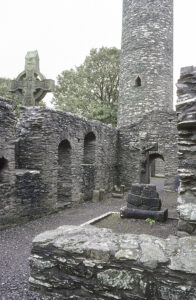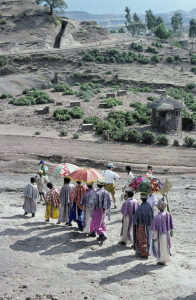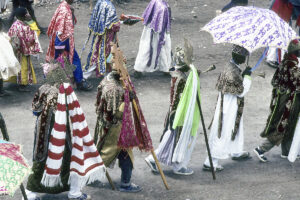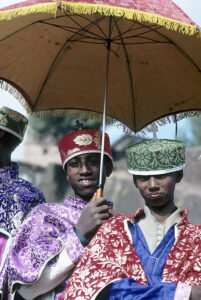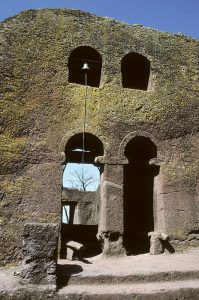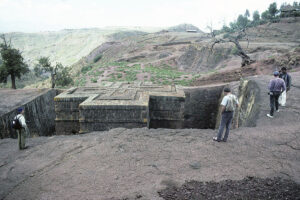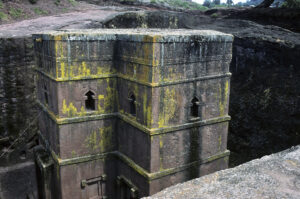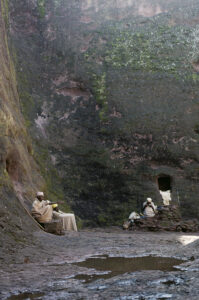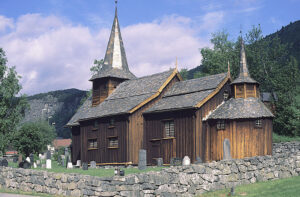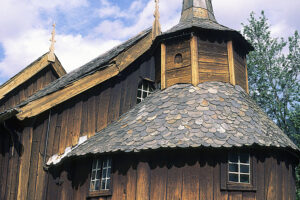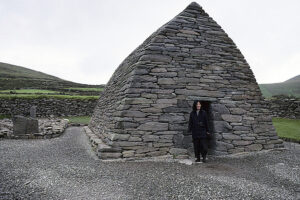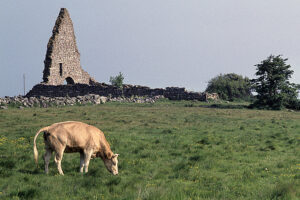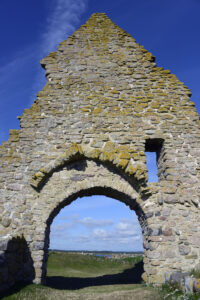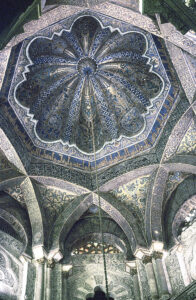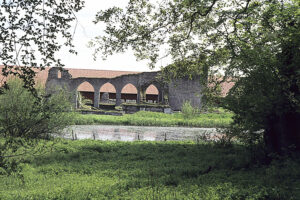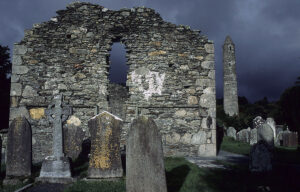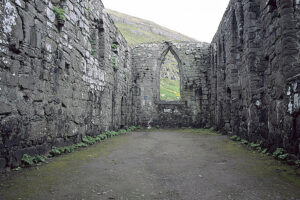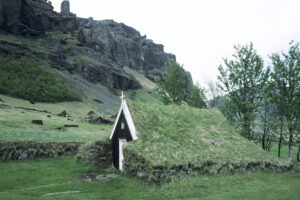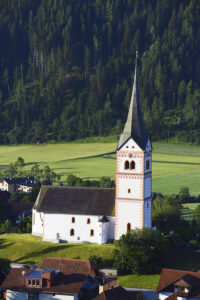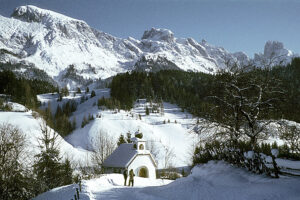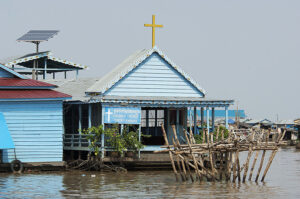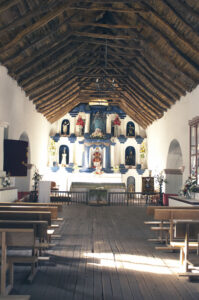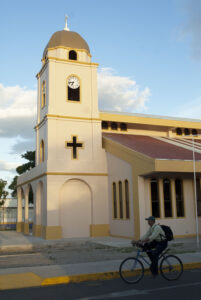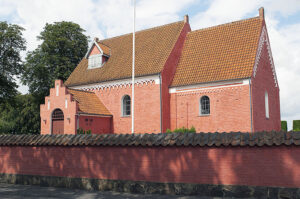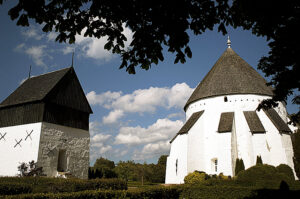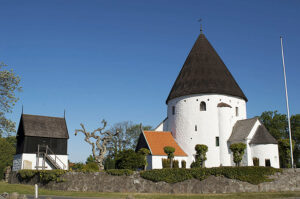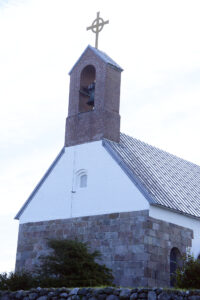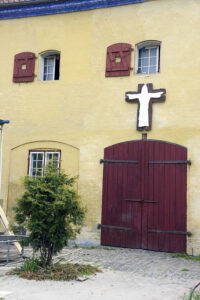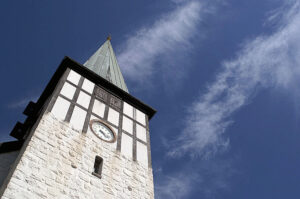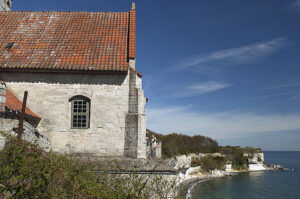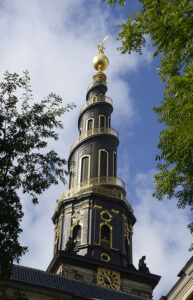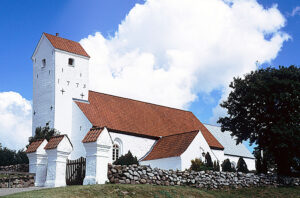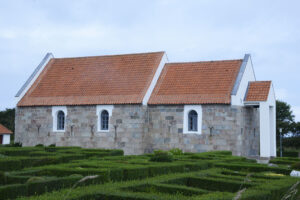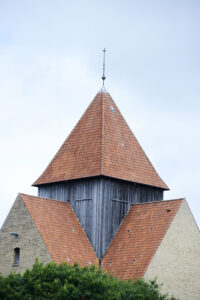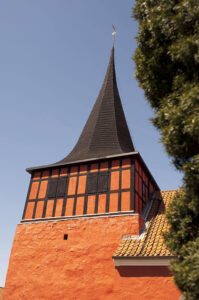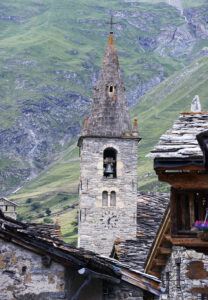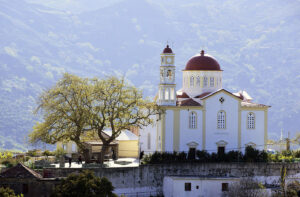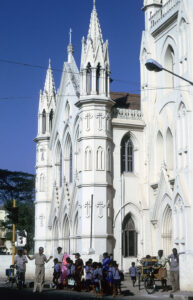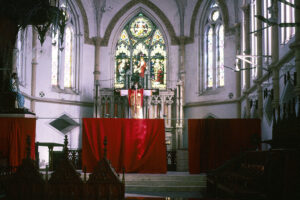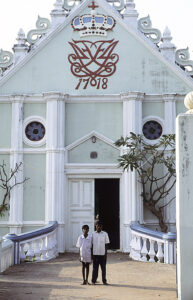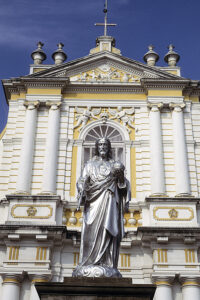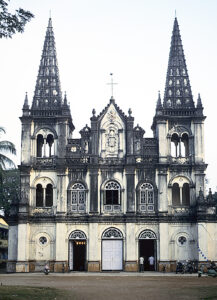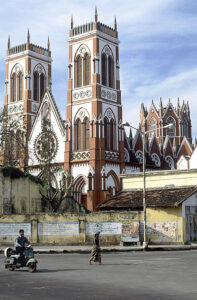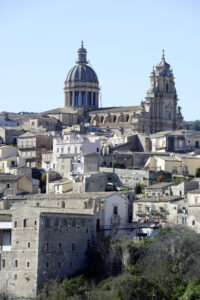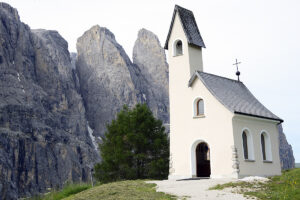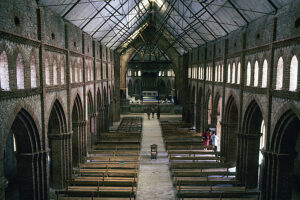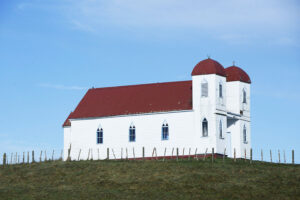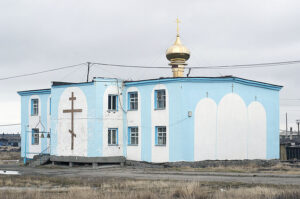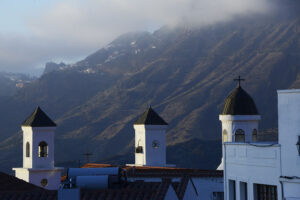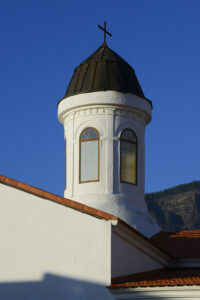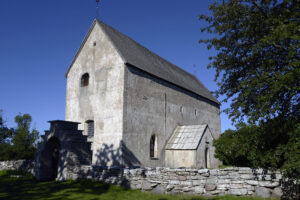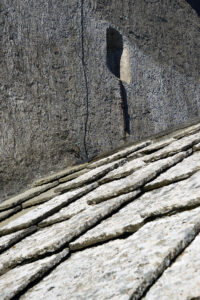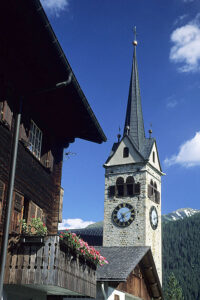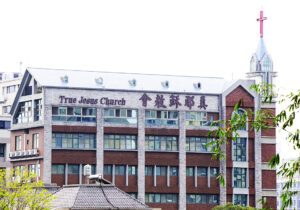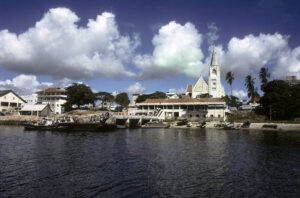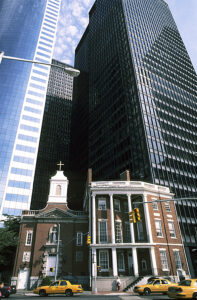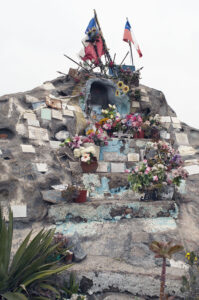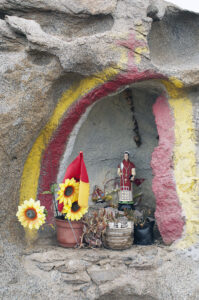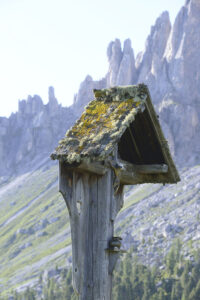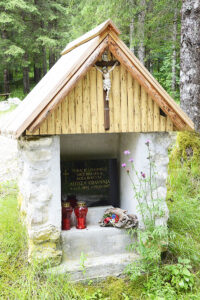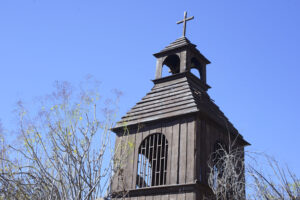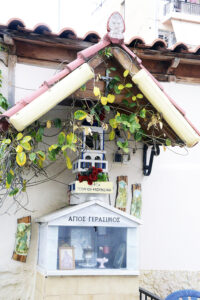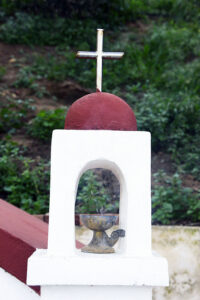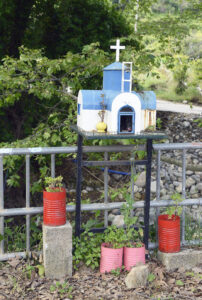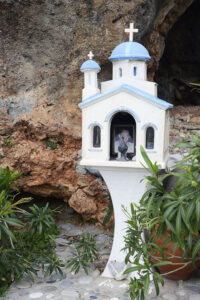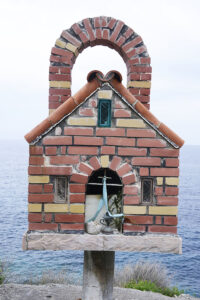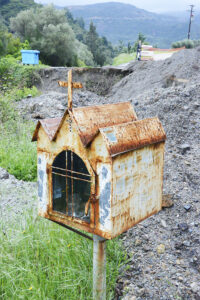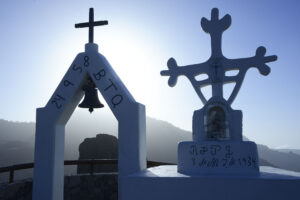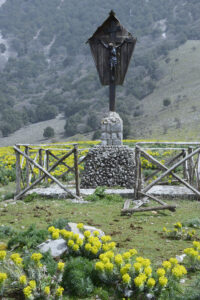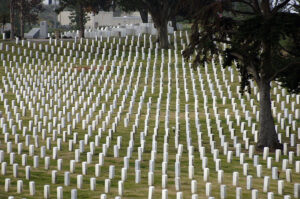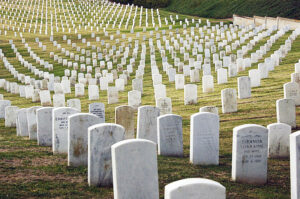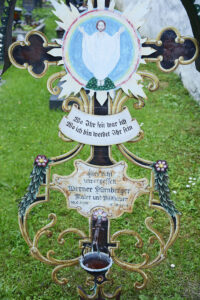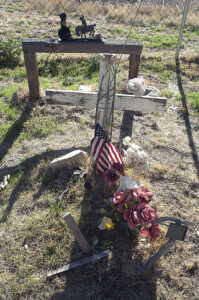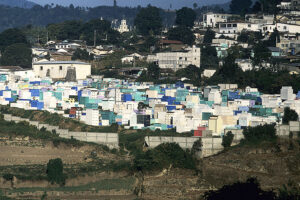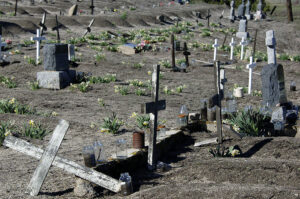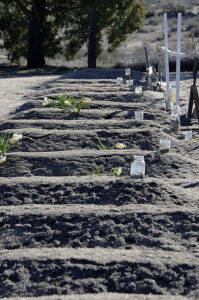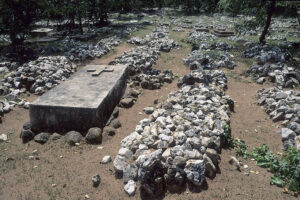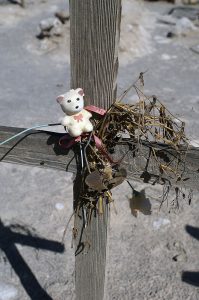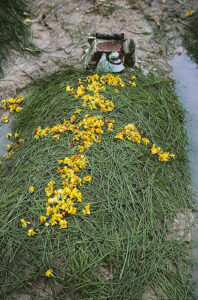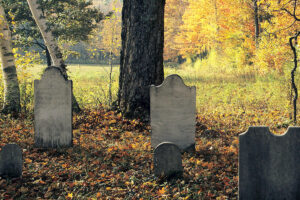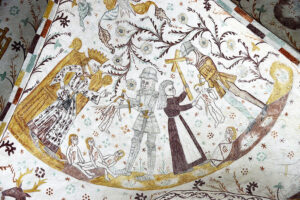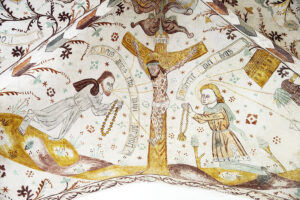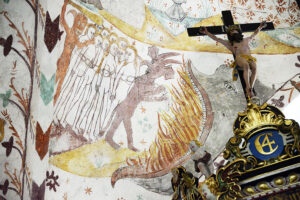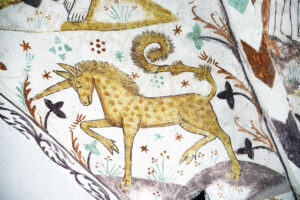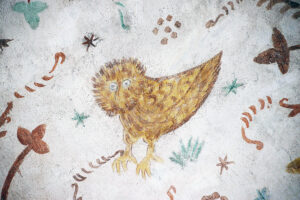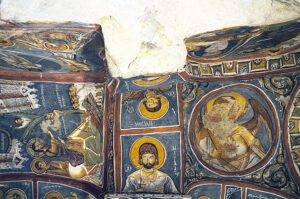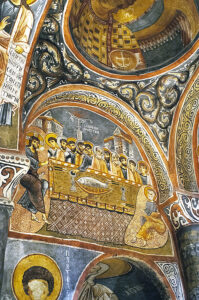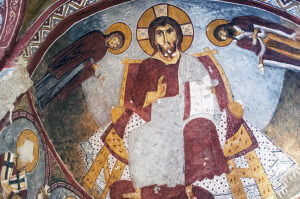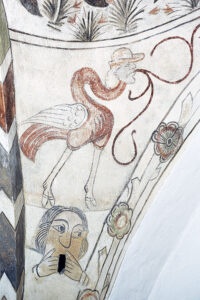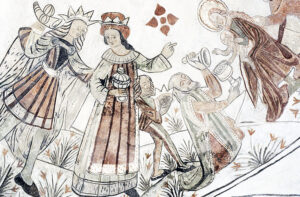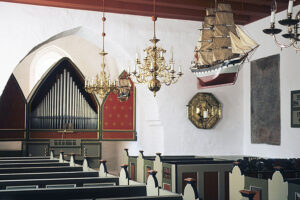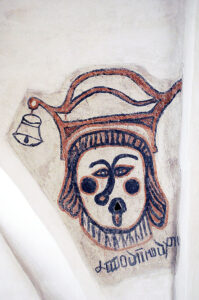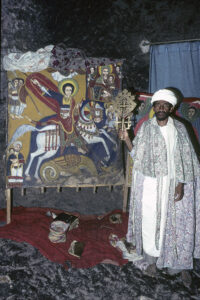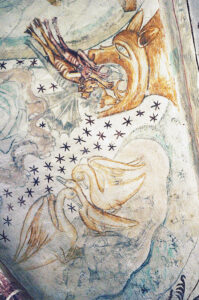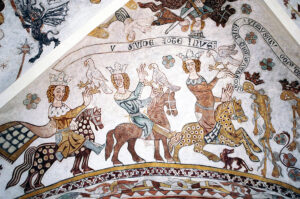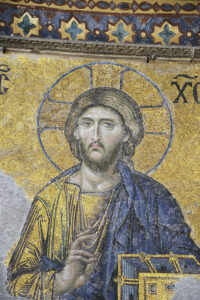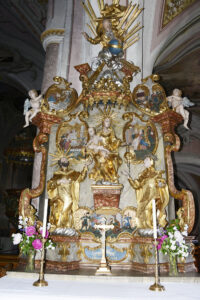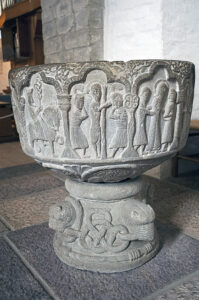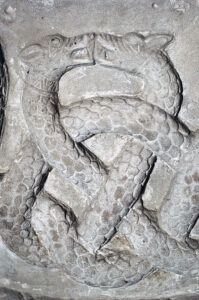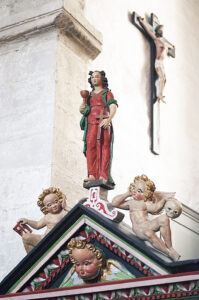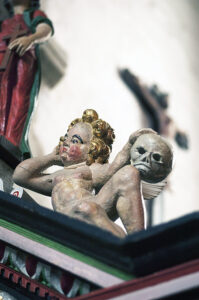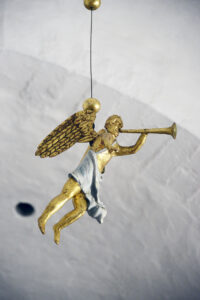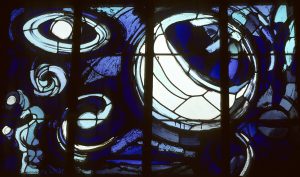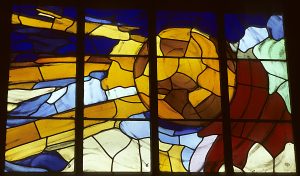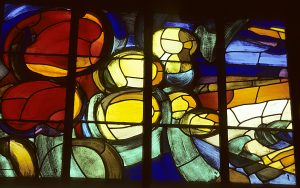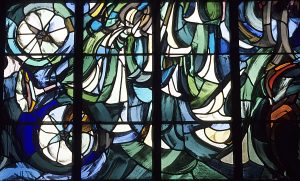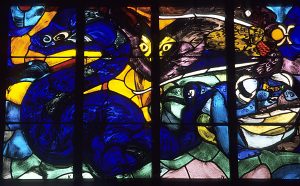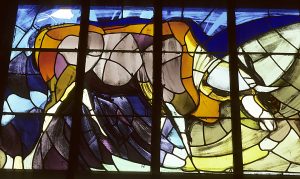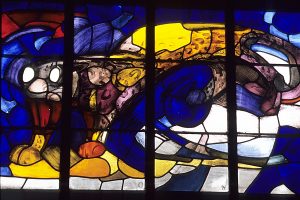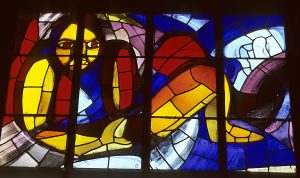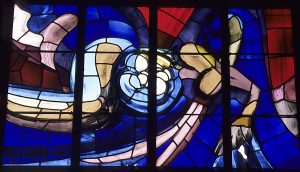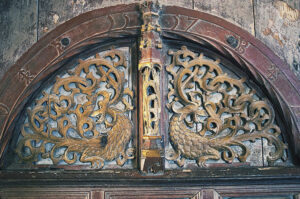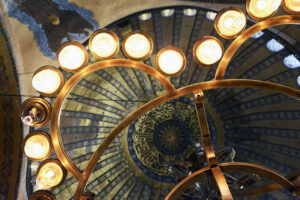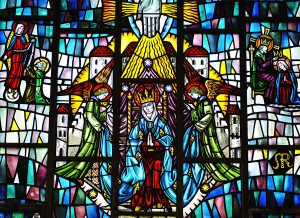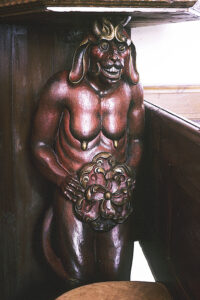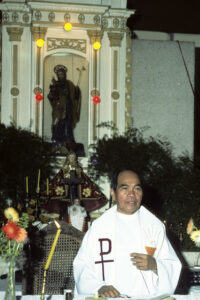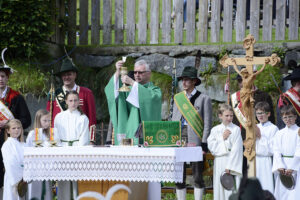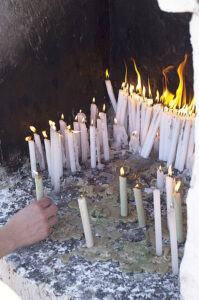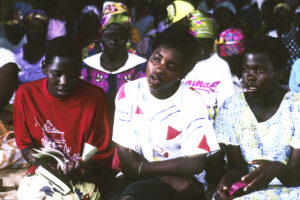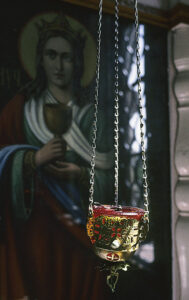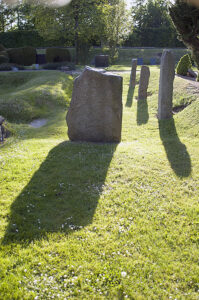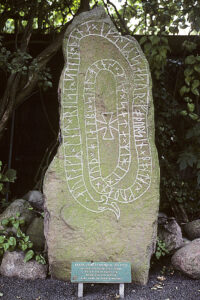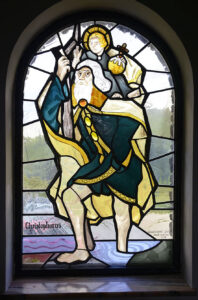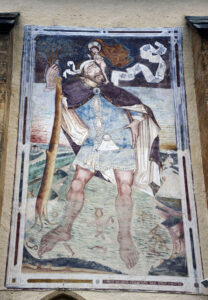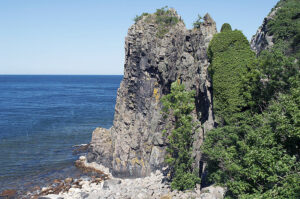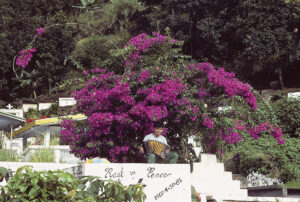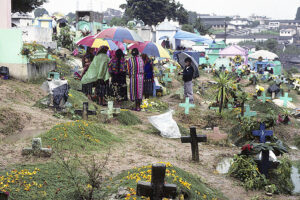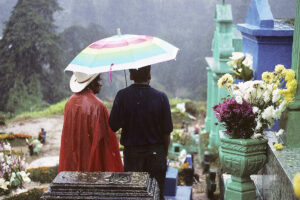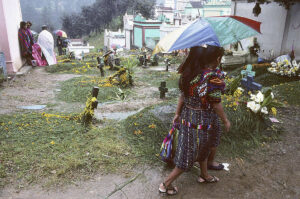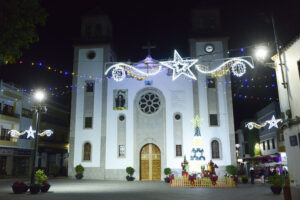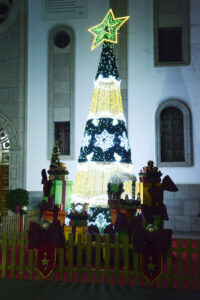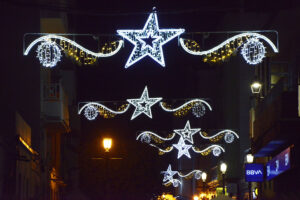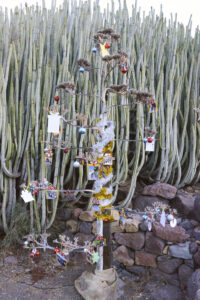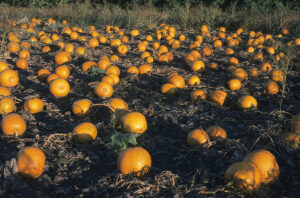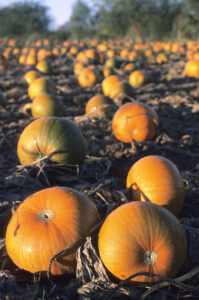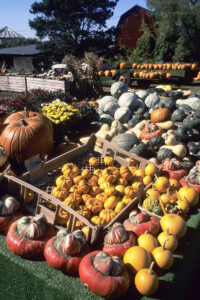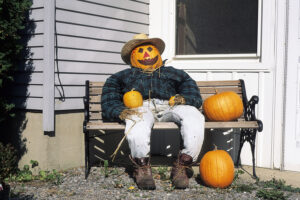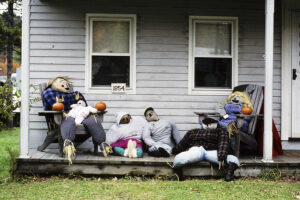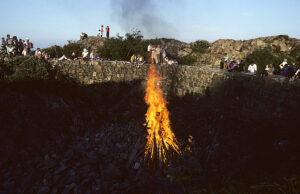Christianity
This gorgeous mosaic from the 800s, depicting Virgin Mary with Jesus, adorns the grand cathedral Hagia Sophia, or ‘Church of the Holy Wisdom’, today called Aya Sofia. – Istanbul, Turkey. (Photo copyright © by Kaj Halberg)
Catholic handicrafts from c. 1890, possibly originating in Germany, depicting the Three Wise Men honouring the infant Christ in the stables. According to legend, one of the Wise Men was black. (Photo copyright © by Kaj Halberg)
Middle Age mural in St. Paul’s Church, Bornholm, Denmark, depicting the crucifixion of Christ. A Roman soldier, clad in European Middle Age dress, pierces the body of Jesus with a lance. Note the skull next to the horse. (Photo copyright © by Kaj Halberg)
Tomb with Christ on the cross, Holtug Church, Zealand, Denmark. The letters INRI are from the Latin, Iesus Nazarenus, Rex Iudaeorum, meaning ‘Jesus the Nazarene, King of the Jews.’ (Photo copyright © by Kaj Halberg)
This statue in the village of Dünzling, near Regensburg, southern Germany, depicts Virgin Mary, patron saint of Bavaria. (Photo copyright © by Kaj Halberg)
Christianity as a religion came into existence around year 30 A.D., at the end of the Easter celebrations, when the disciples of Jesus of Nazareth were convinced that he had arisen from the dead. Their new faith was based on Judaism, but of major importance was now the words and deeds of Jesus, his resurrection, and the pact that he, through his death, had made between God and humans.
His disciples now commenced major missionary work, especially Paul, who translated the Christian thoughts into Greek, which in those days was a collective language in the civilized world. Crucial in the new thoughts were the words Saviour, the Lord, the Son of God, and Remission of Sins. Some scholars maintain that, in reality, Christianity was created by Paul, as he changed the gospel of Christ, which stated that Our Father is Our Saviour. Instead, Paul now stated that Jesus Christ is Our Saviour. Missionary work was also expressed through the gospels, written by the four evangelists: Matthew, Mark, Luke, and John.
The word Christ is from the Greek khristos, which was introduced as a substitute for the word messiah – a Greek corruption of the Aramaic word meschicha, meaning ’the anointed one’. In Ancient Judæa, kings and priests were anointed, hereby being initiated to propagate God’s will and blessings to the people. Over time, the conception of Messiah was transformed into a belief that a new king of David’s line would arise on the very last day. Followers of Jesus regarded him as the new Messiah, who would save humanity. According to some authorities, the concept of Christ as the Son of God, who had descended to Earth, was instigated several hundred years after his death.
Initially, the new Christian missionary work had a free and open theological thinking as a result. Soon, however, this thinking succumbed to lust for power, and, similar to Judaism, a number of controlling posts evolved, such as deacons, priests, and bishops. Eventually, powerful Christian hierarchies came into existence, which had almost full control of European state affairs, as well as an immense influence on culture, with the Pope in Rome as supreme authority. In the 11th century, a breach between Rome and Byzantium took place, causing the eastern, Greek-Orthodox Church to be almost completely isolated from the Roman Catholic Church, the former now having a Patriarch as the highest authority.
In the 1500s, the so-called Reformation took place, in which a number of scholars, under the leadership of Martin Luther, broke with the Pope in Rome, the result of which was a number of Protestant Churches, including Lutheranism and the Anglican Church, which, again, have been split into a large number of creeds and sects.
The Greek-Orthodox Church was also divided into many branches, including the Coptic Church of Alexandria, the Armenian Apostolic Church, the Syriac Orthodox Church, the Ethiopian Tewahedo Church, and the Malankara Church of India. These churches believe in the one single unified Nature of Christ, i.e. a union of the divine and human natures into one is necessary to accomplish the divine salvation of humankind.
This metal relief in the town of Morisaka, eastern Taiwan, depicts a scene from the Passion of Jesus Christ, in which he is carrying his own crucifixion cross to the Golgotha Hill. Exhausted, Jesus has just fallen to the ground, being kicked by a Roman soldier. (Photo copyright © by Kaj Halberg)
Bronze door in Ribe Cathedral, Denmark, depicting the symbols of the four Christian evangelists: Matthew (winged man), Mark (winged lion), John (eagle), and Luke (winged ox). (Photo copyright © by Kaj Halberg)
Fishing boats, Chipoka, Lake Malawi. – Obviously, the one in front is owned by a devout Christian, who has painted the following text on it: “What shall I do to be saved?” (Photo copyright © by Kaj Halberg)
Catholic nuns and school teachers, Mysore, Karnataka, South India. (Photo copyright © by Kaj Halberg)
Early Christians
One of Christendom’s most gorgeous buildings is the Byzantine church ‘Church of the Holy Wisdom’ in Istanbul, Turkey, usually called Hagia Sophia, or, in Turkish, Aya Sofia. This grand structure, which was erected 532-537 during the reign of Roman Emperor Justinian, was converted into a mosque in 1453, and today it is a museum.
Hagia Sophia, or Church of the Holy Wisdom, Istanbul. In the foreground is an avenue of flowering horse-chestnut trees (Aesculus hippocastanum). (Photo copyright © by Kaj Halberg)
Interior of Hagia Sophia. The Ottoman Muslim medallions in the upper corners are adorned with Arabic calligraphy. (Photo copyright © by Kaj Halberg)
Ceiling in Hagia Sophia, adorned with Arabic calligraphy. (Photo copyright © by Kaj Halberg)
Mosaic from the 1100s, depicting Virgin Mary and Jesus, flanked by Emperor John II Komnenos and Empress Eirene. (Photo copyright © by Kaj Halberg)
The Saint Catherine Monastery in Sinai, Egypt, which is officially named Sacred Monastery of the God-Trodden Mount Sinai, was constructed between 548 and 565, thus being one of the oldest working Christian monasteries in the world.
Saint Catherine Monastery, seen from a trail, leading to the peak of Djebel Musa (Mount Moses), where Moses, according to The Book of Exodus, received the two tablets with the Ten Commandments inscribed. (Photo copyright © by Kaj Halberg)
Skulls of deceased monks are kept in a separate room in Saint Catherine Monastery. Note the padlock. Without it, light-fingered tourists would undoubtedly steal some of the skulls as souvenirs. (Photo copyright © by Kaj Halberg)
These rock caves in central Anatolia, Turkey, were formerly inhabited by a Christian people. In one of the caves, a cross has been carved into the wall. (Photos copyright © by Kaj Halberg)
Mainistir Bhuithe (in English Monasterboice) is an early Christian monastery in County Louth, Ireland, founded by Saint Buite, who died in 521.
Ruins of Mainistir Bhuithe. From the tower, Christians were called to prayer. Note the crucified Christ and the tombstone, formed as a cross with a circle. (Photo copyright © by Kaj Halberg)
The predominant religion in Ethiopia is an ancient, orthodox form of Christianity, the Tewahedo Church. The most important festival of this church is Timkat, the Ethiopian Epiphany, usually celebrated on January 19. This festival is best known for its ritual re-enactment of baptism, celebrating the baptism of Christ in the Jordan River.
The town of Lalibela, in northern Ethiopia, is famous for its unique array of churches and monasteries, dating back to the 11th and 12th centuries. Many of these buildings are carved down into the bedrock, which is soft, red, volcanic tuff.
The Tewahedo Church and Lalibela are described in detail on the page Travel episodes – Ethiopia 1996: Timkat – a Christian festival.
In Lalibela, this procession of priests is celebrating Timkat. Some of the priest seek protection from the fierce sun beneath large umbrellas. (Photos copyright © by Kaj Halberg)
This church in Lalibela is called the Mashal Chapel. (Photo copyright © by Kaj Halberg)
The most striking of the stone churches in Lalibela is Beit Giyorgis, which is shaped like a cross. You enter this church by walking in an underground tunnel, or by using a ladder, leaning against the sheer rock wall. Yellow and grey lichens grow on the walls. (Photos copyright © by Kaj Halberg)
Some of the priests in Lalibela live in small caves, with sheep skins to keep themselves warm during the cold nights. Note the growth of algae on the rock wall. (Photo copyright © by Kaj Halberg)
Inside the churches are a number of archaic artefacts, including splendid silver crosses. (Photo copyright © by Kaj Halberg)
A number of wooden stave churches, in Norwegian stavkirke, were constructed in Norway during the 12th and 13th Centuries.
Lom Stavkirke, in the Gudbrand Valley, is one of the largest stave churches in Norway. (Photos copyright © by Kaj Halberg)
Hol Stavkirke. (Photos copyright © by Kaj Halberg)
Séipéilín Ghallarais (Gallarus Oratory) in Dingle, south-western Ireland, is a restored stone building from c. 8th Century, which has been variously interpreted as a church or a shelter for pilgrims.
(Photo copyright © by Kaj Halberg)
Birgitta Birgersdotter (‘Holy Birgitta’) was a Swedish saint, born around 1303, who died in Rome 1373, during a pilgrimage to the Holy Land. According to legend, the ship, which brought back her eartly remains from Rome in 1374, landed at Kapelludden, on the island of Öland, Sweden. Later, a chapel called Sankta Brita’s Kapell (‘Saint Birgitta’s Chapel’) was erected at this place.
Another legend has it that the chapel is dedicated to a Celtic female saint, Brigida.
The ruined Sankta Brita’s Kapell is 27 m long and 12 m wide. (Photos copyright © by Kaj Halberg)
Christian stone cross from the 1200s, standing next to Sankta Brita’s Kapell. (Photo copyright © by Kaj Halberg)
The famous mosque El Mezquita in the city of Córdoba, Andalusia, Spain, was erected between the 8th and the 10th century – one of the earliest and most beautiful examples of Spanish Muslim architecture. Inside, the ceiling is supported by 850 columns, made from granite, jasper, and marble. Following the expulsion of the Moors from Spain in 1492, this mosque was converted to a cathedral, but luckily its gorgeous architecture was preserved.
Detail of the ceiling in El Mezquita, Córdoba. (Photo copyright © by Kaj Halberg)
Alvastra Abbey was a Cistercian monastery near Omberg, Östergötland, Sweden, which was founded in the 12th century.
Ruins of Alvastra Abbey, Omberg. (Photo copyright © by Kaj Halberg)
Around 800 A.D., in Gleann Dá Loch (‘Valley of Two Lakes’), south-eastern Ireland – in English called Glendalough – a cathedral, a graveyard, and a round tower were built. From the tower, believers were called to prayer.
The ruined cathedral, tombstones, and the round tower, Gleann Dá Loch. (Photo copyright © by Kaj Halberg)
Ruins of the Reefert Church, likewise at Gleann Dá Loch, erected around 1000 A.D. (Photo copyright © by Kaj Halberg)
At the ancient settlement of Kirkjubøur, Streymoy, Faroe Islands, a magnificent cathedral, called St. Magnus Church, was erected during the 1300s.
Today, St. Magnus Church is in ruins. (Photo copyright © by Kaj Halberg)
Around the 11th Century, in what is today Göreme, central Turkey, numerous monasteries and churches were carved into eroded tuff rocks and spires.
Karanlık Kilise (‘Dark Church’), one of the ancient churches in Göreme. (Photo copyright © by Kaj Halberg)
The tiny Salomon’s Chapel was constructed in the 1300s on Hammerknuden, the northern tip of the island of Bornholm, Denmark. In those days, enormous numbers of herrings were landed in a small local harbour, named Kragkås, and the Archbishop of Lund (in present-day Sweden) was of the opinion that the large population of fishermen here should have a church. The archbishop died in 1379, and in his will, it is stated that a silver spoon should be bestowed on ”…capelle sancti Salomonis in Borandaholm.”
The chapel possibly takes its name from Salomonius (1231-1314), a mystic of the Dominican Order. When the large herring boom ended in the 1500s, the harbour was deserted, and the chapel fell into decay.
Ruin of Salomon’s Chapel. The tree in the foreground is a Swedish whitebeam (Sorbus intermedia). (Photo copyright © by Kaj Halberg)
Preserved early church with grass roof, Nupsstaður, Iceland. (Photo copyright © by Kaj Halberg)
Churches
Churches around the world come in a tremendous variety of forms and size, as is evident from the collection of pictures below, arranged alphabetically according to countries.
Austria
Morning light on a Roman Catholic church in the village of Sankt Peter am Kammersberg, Styria. (Photo copyright © by Kaj Halberg)
White Roman Catholic church in a white winter landscape, Lammartal, Salzburg. The mountain range in the background is Gosaukamm. (Photo copyright © by Kaj Halberg)
Cambodia
Church in a Vietnamese ‘floating’ village, situated in Lake Tonle Sap. Other pictures from this village may be seen on the page Culture: A place to live. (Photo copyright © by Kaj Halberg)
Chile
Inside the Catholic church of San Pedro de Atacama. (Photo copyright © by Kaj Halberg)
Costa Rica
Morning light on a Roman-Catholic church, Bagaces, Guanacaste. (Photo copyright © by Kaj Halberg)
Denmark
It is believed that Godsted Church, south of the town of Sakskøbing, Lolland was first built before 1300. Choir and nave are in Romanesque style, whereas the porch is newer. The church is without a tower, but formerly had a separate wooden bell tower.
(Photo copyright © by Kaj Halberg)
Seven round churches exist in Denmark, five of which are on the island of Bornholm, in the Baltic Sea. These churches were erected as veritable fortifications, with dual functions: a place of worship, and a refuge during invasions.
The largest of the round churches on Bornholm is Østerlars, constructed c. 1150 of cleaved boulders, in three storeys. It is dedicated to Saint Laurentius (St. Lawrence of Rome, c. 225-258), who, by order of Emperor Valerian, was executed in 258, being roasted alive on an iron grill. In Danish, his name is shortened to Lars, whereas øster means ‘eastern’.
Østerlars Church. (Photo copyright © by Kaj Halberg)
Ols Church, 13 m high, is a slender round-church from the 1100s or 1200s, situated on top of a small hill, 112 m above sea level, northern Bornholm. This church is dedicated to Saint Olaf the Holy One, who, before his canonization, was King Olaf II Haraldsson of Norway (995-1030). Apparently, the Catholic Church took a liberal view of his brutal conduct as a king.
Ols Church. (Photo copyright © by Kaj Halberg)
It is believed that Vester Vandet Church, Thy, was first erected in the 1100s. Its apse consists of large granite blocks. The clock tower was built of red bricks in 1905, with an iron circular cross, covered in lead. It replaced a former wooden bell tower.
Vester Vandet Church, Thy. (Photo copyright © by Kaj Halberg)
Christiania is a community in Copenhagen with alternative ways. It is described in depth on the page Culture: Folk art around the world.
The cross above the church entrance in Christiania is formed as Jesus, blessing people. (Photo copyright © by Kaj Halberg)
Nicolai Church in the town of Rønne, Bornholm, is dedicated to Nicolaus, patron saint of sailors, lawyers, bakers, and other trades, and especially of children. He is identical to Santa Claus, who, according to an ancient belief, brings gifts to children on Christmas Night, creeping down the chimney to place the gifts in stockings, tied to the children’s beds.
Condensed exhaust from a jet plane draws lines in the sky above Nicolai Church, Rønne, Bornholm. (Photo copyright © by Kaj Halberg)
Højerup Old Church, Stevns, Zealand, was erected in limestone around 1250-1300. Previously, it was situated quite far from the vertical cliffs of Stevns Klint, but the choir and part of the graveyard fell into the sea in 1928.
The remains of Højerup Old Church still balance precariously on the edge of Stevns Klint, but may fall into the sea at any time. (Photo copyright © by Kaj Halberg)
Vor Frelser Kirke (‘Church of Our Saviour’) in Copenhagen was constructed 1682-1695. However, its well-known helix spire, with an external winding staircase, was added later, 1747-1752.
(Photo copyright © by Kaj Halberg)
Choir and nave of Stødov Church, also called Helgenæs Church, in eastern Jutland, were constructed of cleaved granite stones during the 1200s. Later, during the Gothic Period, tower and porch were added.
(Photo copyright © by Kaj Halberg)
Aa Church, which has given name to the town of Aakirkeby, Bornholm, is dedicated to Saint John the Baptist. It was constructed of granite around 1150, with many additions and restorations taking place since then. The tower, with a twin roof, is 22 m high, built in the 1500s.
(Photo copyright © by Kaj Halberg)
Originally, the town of Hanstholm, Thy, was named Hansted, and the church has kept the old name. It is a typical Romanesque style church, originally erected in the 1100s.
Hansted Church, Thy. (Photo copyright © by Kaj Halberg)
Mariehøj Church, Silkeborg, Jutland, is shaped like a cross. It was built in 1958, using yellow bricks on a foundation of granite stones, and with a wooden tower in the centre. Architecturally, it is inspired by the ruins of St. Lars Church and the Church of the Holy Spirit in Visby, Gotland, Sweden.
Mariehøj Church. (Photo copyright © by Kaj Halberg)
Fanefjord Church, on the island of Møn, was constructed around 1300. It is richly decorated with Middle Age murals, made by the so-called ‘Elmelunde Master’ (see caption Church interior below).
Evening light on Fanefjord Church. (Photo copyright © by Kaj Halberg)
Originally, Svaneke Church, on the island of Bornholm, was erected around 1350, but today only a tiny bit of the old church has been preserved in the southern wall of the present building.
(Photo copyright © by Kaj Halberg)
The almost symmetric church in the town of Bagenkop, Langeland, is a fairly recent building, erected in 1920.
(Photo copyright © by Kaj Halberg)
France
Church tower, Bonneval-sur-Arc, Val d’Arc, Alps. (Photo copyright © by Kaj Halberg)
Greece
Two orthodox churches on the island of Crete, in Laki (top), and on the Rodopos Peninsula. (Photos copyright © by Kaj Halberg)
India
The San Thome Cathedral, also known as St. Thomas Cathedral, is a Roman Catholic church in the city of Chennai, Tamil Nadu. It was erected in the 16th Century by the Portuguese, over the tomb of Saint Thomas, one of the twelve apostles of Jesus. In 1893, it was rebuilt by the British as a church with the status of a cathedral. The British version still stands today.
San Thome Cathedral, Chennai. (Photo copyright © by Kaj Halberg)
Interior of the San Thome Cathedral. (Photo copyright © by Kaj Halberg)
In November 1618, the Danish King Christian IV ordered one of his admirals, Ove Giedde, to be the commander of a fleet of five ships, bound for India. The aim of this journey was to establish a trading station under the Royal Danish East India Company, to be able to bring cheap spices and textiles to the Motherland.
Two years later, Giedde and his crew reached the Coromandel Coast, at the mouth of River Kaveri in present-day Tamil Nadu. Following negotiations with the Prince of Thanjavur, Giedde obtained permission to build a trading station, which was called Trankebar (in English Tranquebar) – a corruption of the local Tamil name of the place, Tarangambadi, which means ‘singing waves’. In 1660, a fort was completed, named Dansborg (’Danish Castle’). Behind this fort, a town sprang up, fortified with moats and walls, through which a number of gates gave access to the town. The largest of these gates is shown on the page Decay.
New Jerusalem Church, Tarangambadi (Tranquebar). The year of construction, 1718, and the monogram of King Frederik IV, who was the patron of this church, are seen above the entrance. (Photo copyright © by Kaj Halberg)
Notre Dame de la Conception is a Jesuit cathedral in Puducherri (Pondicherry), South India. Completion of this grand building lasted more than 70 years, from 1691 to 1765.
(Photo copyright © by Kaj Halberg)
Santa Cruz, a Catholic cathedral in Kochi, Kerala, was built in 1887.
(Photo copyright © by Kaj Halberg)
L’Eglise de Sacre Coeur de Jesus (‘Basilica of the Sacred Heart of Jesus‘) in the city of Puducherri (Pondicherry), southern India, is a splendid Gothic building, constructed in the 1700s.
(Photo copyright © by Kaj Halberg)
Italy
Santa Maria dell’Itria is a Baroque-style Roman Catholic church from the 1700s in the city of Ragusa, Sicily. The name is derived from the Greek odigitria, meaning ‘Our Lady of the Way’.
(Photo copyright © by Kaj Halberg)
This diminutive Roman Catholic church, seating capacity 12, was built in 2004 at Passo Gardena, Dolomites. (Photo copyright © by Kaj Halberg)
Kyrgyzstan
Trinity Church, a wooden Russian-Orthodox cathedral in the city of Karakol, dates from around 1900. This grand building, which was restored in the 1990s, houses a famous icon, which formerly belonged to the church in the town of Svetly Mys. In 1916, during a rebellion against the tsar, all but two monks of this church were murdered. It is told that the icon shed tears after this incident.
Trinity Church, Karakol. (Photo copyright © by Kaj Halberg)
Malawi
The pride of the tiny Likoma Island, Lake Malawi, is its huge cathedral, an impressive building, which was inspired by the cathedral in Salisbury, England, and almost as large. Construction began in the late 1800s and was completed in 1911. An enormous building like this seems rather out of place on this tiny island – perhaps telling more about the ambitions of a bishop rather than the need of the inhabitants.
Interior of the cathedral on Likoma Island. (Photo copyright © by Kaj Halberg)
New Zealand
The Ratana Church was founded by Tahupotiki Wiremu Ratana, a Methodist Maori farmer who acquired a reputation as a visionary healer. In 1920, he established a church at the village of Ratana Pa, near Whanganui, and later several other Ratana churches were built around New Zealand.
This Ratana church in Raetihi is named Te Whare Whakamoemiti (‘The House of Praise’). (Photo copyright © by Kaj Halberg)
The Baptist church in Kawakawa, North Island, is very colourful. (Photo copyright © by Kaj Halberg)
Russia
Orthodox church, Anadyr Airport City, Chukotka, eastern Siberia. (Photo copyright © by Kaj Halberg)
Spain
The splendid Parroquia de Nuestra Senora del Socorro (‘Parish of Our Lady of Socorro’) in the town of Tejeda, Gran Canaria, was founded in 1648.
(Photos copyright © by Kaj Halberg)
Nests of white stork (Ciconia ciconia) on the roof of a church tower in the town of Trujillo, Extremadura. (Photo copyright © by Kaj Halberg)
Sweden
Källa Old Church, on the island of Öland, is a well-preserved church ruin. It was first built in the 1100s or 1200s. The church was deserted in 1880, when a new church was erected nearby.
Källa Old Church. The lower picture shows the roof of the porch. (Photos copyright © by Kaj Halberg)
Switzerland
The tower of this church in the village of Sedrun, Tavetsch Valley, Graubünden, ends in a towering spire. (Photo copyright © by Kaj Halberg)
Taiwan
The True Jesus Church is a Protestant church, which originated in China during the Pentecostal movement in the early 1900s. Pentecostalism places special emphasis on a direct personal experience of God through the baptism with the Holy Spirit.
I wonder, why this church is called True Jesus Church. Does anybody believe in a False Jesus?
True Jesus Church, Taichung. (Photo copyright © by Kaj Halberg)
Illuminated cross on a church, Tienhsiang, Taroko Gorge. (Photo copyright © by Kaj Halberg)
Tanzania
Saint Joseph’s Metropolitan Cathedral is a Gothic style church near the harbour of Dar es Salaam. It was erected between 1897 and 1902, during the German occupation of Tanzania.
(Photo copyright © by Kaj Halberg)
United States
Cades Cove Primitive Baptist Church in Great Smoky Mountains National Park, Tennessee, was established in 1827. Until 1832, the church did not have a building, and members met in private homes. The original building was built out of crude, unfinished logs, and it is not the building you see today, which was constructed in 1887.
Interior of Cades Cove Primitive Baptist Church. (Photo copyright © by Kaj Halberg)
This church in Manhattan, New York City, is dwarfed by surrounding skyscrapers. (Photo copyright © by Kaj Halberg)
Other shrines
Typical Catholic road altar, depicting the crucified Christ and the Madonna, Höhlenstein Valley, Tre Cime Area, Dolomites, Italy. Note the water bottle and the scented geranium. (Photo copyright © by Kaj Halberg)
Roadside shrine, dedicated to Santa Gemita, or Virgen del Camino, protector of travellers, north of Caldera, Chile. (Photos copyright © by Kaj Halberg)
Weather-beaten Catholic road altar, depicting the crucified Christ, Passo delle Erbe (Börz Würzjoch), Dolomites, Italy. (Photo copyright © by Kaj Halberg)
Catholic road altar, erected to commemorate a deceased person, Krajcarca Valley, near Trenta, Triglavski National Park, Slovenia. (Photo copyright © by Kaj Halberg)
Wooden bell tower, Gran Canaria. (Photo copyright © by Kaj Halberg)
Various Greek orthodox road altars, Crete. The one in the bottom picture miraculously escaped being swept away by a major landslide, following heavy rain, which destroyed part of the road. (Photos copyright © by Kaj Halberg)
Cross and bell, El Toscón, Gran Canaria. (Photo copyright © by Kaj Halberg)
Road shrine, depicting Christ on the Cross, Parco delle Madonie, near Collesano, Sicily. The plant with yellow flowers is a species of spurge, Euphorbia segetalis. (Photo copyright © by Kaj Halberg)
Cemeteries
Many more cemeteries and tombstones are presented on the page Culture: Graves.
An abundance of identical tombstones in the Veterans’ Graveyard, Cabrillo Memorial, San Diego, California. (Photos copyright © by Kaj Halberg)
Grave in the village of Thomatal, Austria. The text beneath the image of Christ says: “Where You were, I was; where I am, You will be.” (Photo copyright © by Kaj Halberg)
This grave in Cottage Grove Cemetery, Kern Valley, California, has been adorned with various items, including plastic flowers and the American national flag, ‘Stars and Stripes’. (Photo copyright © by Kaj Halberg)
Many of the sepulchral monuments in this graveyard in Solola, Guatemala, are painted in lively colours. (Photo copyright © by Kaj Halberg)
Cahuilla Cemetery, California, is a resting place for mainly Native Americans. The flowers are daffodils (Narcissus pseudonarcissus). (Photos copyright © by Kaj Halberg)
The cemetery on Likoma Island, Lake Malawi, is unique. Because of the rocky surface of the island, most graves are above ground, covered by numerous small rocks, sometimes with a stone or iron cross squeezed between the stones. (Photo copyright © by Kaj Halberg)
This grave in the cemetery at Pueblo Pampa Union, a deserted mining town north of Carmen Alto, Chile, is adorned with a tiny teddy bear and flowers, which have withered. (Photo copyright © by Kaj Halberg)
This new grave in Chichicastenango, Guatemala, has been decorated with grass and a cross, made from marigolds. (Photo copyright © by Kaj Halberg)
Tombstones and autumn colours, New Lebanon, New York State. (Photo copyright © by Kaj Halberg)
Church interior
During the Middle Ages, numerous churches were adorned with colourful murals, for the major part depicting events from the Bible. However, many of the paintings incorporate scenes from everyday life of people, besides plants, animals, and various supernatural creatures. Below a selection of photographs shows examples of this artwork.
Elmelunde Church, on the island of Møn, Denmark, is adorned with countless murals, painted around 1480 by an unknown artist, who has been labelled ‘The Elmelunde Master’. The following 6 pictures show examples of his artwork.
Eve’s ‘birth’. (Photo copyright © by Kaj Halberg)
The Child Murder in Bethlehem. (Photo copyright © by Kaj Halberg)
Crucifixion of Jesus. (Photo copyright © by Kaj Halberg)
Devils, leading lost souls to the Mouth of Hell. (Photo copyright © by Kaj Halberg)
Unicorn. (Photo copyright © by Kaj Halberg)
Short-eared owl (Asio flammeus). In those days, this owl was a rather common breeding bird in Denmark. Today, however, it is very rare. (Photo copyright © by Kaj Halberg)
In Göreme (see caption Early Christians above), many of the churches are adorned with murals on walls and ceiling. Unfortunately, some of the paintings were vandalized by Muslims, when they conquered this area.
Joseph and the pregnant Maria, riding a donkey, Karanlık Kilise (‘Dark Church’). (Photo copyright © by Kaj Halberg)
The Last Supper, Karanlık Kilise. (Photo copyright © by Kaj Halberg)
Christ, trampling a devil-like figure, Karanlık Kilise. (Photo copyright © by Kaj Halberg)
Mural in Çarıklı Kilise (‘Sandal Church’), depicting Christ. The name of this church was given in allusion to the two footprints on the Ascension fresco near the entrance. (Photo copyright © by Kaj Halberg)
Vesterø Søndre Kirke (’Vesterø Southern Church’), on the island of Læsø, Denmark, was constructed in Romanesque style around 1250. Originally, it was built of large bricks, but in 1777, the southern wall was plastered with pebbles, and the church was painted red – one of the few Danish churches of this colour.
These unusual murals in Vesterø Southern Church depict an ostrich with a human head, and a man with a ventilation hole as a mouth, making him look as if he sticks out his tongue at the churchgoers! (Photo copyright © by Kaj Halberg)
This mural in Vesterø Southern Church depicts the Three Wise Men, bringing gifts to the infant Jesus. (Photo copyright © by Kaj Halberg)
Vesterø Southern Church is also adorned with several multi-branched chandeliers and a ship’s model. (Photo copyright © by Kaj Halberg)
Mural from 1516, depicting a court jester, Jungshoved Church, Zealand, Denmark. (Photo copyright © by Kaj Halberg)
Saint George was a Roman soldier, who was executed around 303 for his Christian belief. He since became the patron saint for farmers, knights, and horsemen. The name George is from the Greek georgos (‘farmer’). A famous legend relates that St. George killed a dragon, which held a princess captive.
Standing in front of a mural, depicting Saint George, killing the dragon, this priest in Lalibela, northern Ethiopia, is showing a golden cross. (Photo copyright © by Kaj Halberg)
Mural in Holtug Church, Zealand, Denmark, depicting swans and a monster, which swallows other monsters. (Photo copyright © by Kaj Halberg)
This mural in St. Paul’s Church, Bornholm, Denmark, depicts serious sins (at least according to certain puritan Christian sects), such as playing music, dancing, and playing games. (Photo copyright © by Kaj Halberg)
Mural, depicting falconers, Skibby Church, Zealand, Denmark. Note the skeletons, and the devil in the upper left corner. (Photo copyright © by Kaj Halberg)
Mosaic from the 1200s, depicting Jesus on Deesis (Doomsday), Hagia Sophia, or ‘Church of the Holy Wisdom’, today called Aya Sofia (see caption Early Christians). (Photo copyright © by Kaj Halberg)
Altarpiece in Oberwölz Church, near Sankt Peter am Kammersberg, Austria. (Photo copyright © by Kaj Halberg)
Aa Church, Aakirkeby, Bornholm, Denmark, is presented above, see caption Churches. The following four pictures show interior of this church.
The baptismal font was carved in sandstone in the 1200s by the Swedish master Sigraf. This font is unique, as it not only depicts scenes from the life of Christ, but also motives from the Norse mythology, including the Midgard Serpent. (Photos copyright © by Kaj Halberg)
The pulpit depicts angels, one holding a skull. In the background Virgin Mary, and Christ on the Cross. (Photos copyright © by Kaj Halberg)
A virtuously dressed angel, blowing a trumpet, Nylars Church, Bornholm, Denmark. (Photo copyright © by Kaj Halberg)
The tiny church in the village of Rondo, southern Tanzania, is adorned with a series of gorgeous stained-glass windows, depicting God’s creations, made by English artist and biologist Jonathan Kingdon.
The galaxies. (Photo copyright © by Kaj Halberg)
The sun. (Photo copyright © by Kaj Halberg)
The planets. (Photo copyright © by Kaj Halberg)
Plants, represented by angel’s trumpet (Brugmansia suaveolens). (Photo copyright © by Kaj Halberg)
Amphibians and reptiles. (Photo copyright © by Kaj Halberg)
Birds, represented by yellow-collared lovebird (Agapornis personata) and brown-hooded kingfisher (Halcyon albiventris). (Photo copyright © by Kaj Halberg)
Mammals, represented by eland antelope (Taurotragus oryx) and leopard (Panthera pardus). (Photos copyright © by Kaj Halberg)
Adam and the pregnant Eve. (Photos copyright © by Kaj Halberg)
In Chinese mythology, the masculine virtues of the dragon and the feminine virtues of the feng-huang (often erroneously called ‘Chinese Phoenix’) complement one another, and they are often depicted together on Daoist temples. These creatures are described in detail on the page Religion: Daoism in Taiwan.
The wood carving in the picture below, exhibited in Højerup Church, Stevns Klint, Zealand, Denmark, is probably influenced by Chinese mythology, as it depicts two creatures, which resemble a mixture of dragon and Feng-Huang.
(Photo copyright © by Kaj Halberg)
Chandelier in the gorgeous cathedral Hagia Sophia, or ‘Church of the Holy Wisdom’, today called Aya Sofia (see caption Early Christians). (Photo copyright © by Kaj Halberg)
A group of Catholic sisters, who called themselves Sisters, Servants of the Immaculate Heart of Mary, arrived at Scranton, Pennsylvania, United States, in 1878, where they established St. Cecilia’s Academy ‘for young ladies’, whereas Mount St. Mary’s Seminary opened in 1902. (The term seminary was roughly equivalent to a high school today). In 1915, Marywood University, a Catholic liberal arts university, was established in Scranton.
The picture below, taken in Our Lady of Lourdes Chapel, the centre chapel of Marywood University, shows a stained-glass window from 1962, depicting Virgin Mary, called the Queen of Heaven. The hand above Virgin Mary is the Hand of God. The small image to the left depicts a legend, in which Mary hands her cincture to the apostle Thomas, as she is assumed into Heaven. The small image to the right shows the crowning of Mary, and beneath is her monogram.
(Photo copyright © by Kaj Halberg)
According to Danish folklore, Slattenpatten (‘Pendulous Breasts’) is an ogress, or elven woman, from southern Zealand, who is easily identified by her very long, pendulous breasts, which, so it was said, were hanging down to her hip. A number of legends relate incidents, where King Valdemar Atterdag was hunting Slattenpatten with his dogs. In such situations, she would sling her breasts over her shoulders, to avoid them being in the way when she had to run fast.
Slattenpatten steals from people at night, but if you mark bread and other pastry with a cross, she is unable to take it. If you are followed by her, you may escape by running across the furrows of a ploughed field, if it has been ploughed with a steel plough, because she cannot stand steel. You may also escape by jumping across a stream, as she doesn’t like running water either. (Source: Evald Tang Kristensen 1893. Danske Sagn, som de har lydt i Folkemunde, Vol. 2)
This carving, depicting an ogress with a dog’s head and pendulous breasts, is found below the pulpit in Vejlø Church, Zealand, Denmark. It probably depicts Slattenpatten. (Photo copyright © by Kaj Halberg)
Church services
Catholic priest, giving a sermon in a church during a wedding, Legazpi, Luzon, Philippines. (Photo copyright © by Kaj Halberg)
Outdoor Catholic church service in the village of Prägraten, Virgental Valley, Tyrol, Austria. (Photo copyright © by Kaj Halberg)
The Unga are a Bantu people, who live in the Bangweulu Swamps, northern Zambia. In former days, they were animists, but today they are all Christians. You may read more about this people on the page Countries and places: Bangweulu – where water meets the sky.
On Sundays, the Unga are called to church service by drums, or, as here, by a boy, beating an old truck rim with a piece of iron. (Photo copyright © by Kaj Halberg)
These Roman Catholics are burning candles at a shrine for Virgin Mary, Cartagena, Chile. (Photos copyright © by Kaj Halberg)
During a baptism ceremony, taking place in a Catholic church in Legazpi, Luzon, Philippines, this young mother lets her baby hold a burning candle. (Photo copyright © by Kaj Halberg)
Achewa girls, singing during a Presbyterian church service, Chembe, Lake Malawi. (Photo copyright © by Kaj Halberg)
Burning incense for Virgin Mary inside the Russian-Orthodox cathedral in the town of Karakol, Kyrgizstan. (Photo copyright © by Kaj Halberg)
Runic stones
At some point during the Iron Age, it became a custom in Scandinavia to erect large stones of granite or slate, so-called runic stones, on graves, engraved with runes, most often in long bands, in many cases ending in a serpent’s or dragon’s head – most probably an image of the Midgard Serpent, a monster which was feared among seagoing peoples, as it supposedly ate drowned seamen.
In many places, erecting runic stones only became a practice, after people had converted to Christianity, around 900-1000. For this reason, inscriptions on these stones all have a Christian stamp. In most cases, they shortly inform you, for whom the stone was erected, and by whom.
Pictures, depicting other runic stones, may be seen on the page Culture: Megaliths.
On the rear side of this runic stone, standing in front of the ruins of the former Østermarie Church, Bornholm, Denmark, a large flower-like figure, a so-called propeller cross, is engraved. The text on this stone translates as follows: “Bjarne and Tue and Asgot erected this stone to commemorate their brother Sibbe. Christ help his soul.” – Menhirs without inscriptions are seen in the background. (Photo copyright © by Kaj Halberg)
Marevadstenen is a runic stone from c. 1100, standing outside Hasle Church, Bornholm, Denmark. The runes on this stone, carved in the form of a serpent, translate as follows: “Aulakr erected this stone to commemorate his father Sasur, a good farmer. God and Saint Michael help his soul.” (Photo copyright © by Kaj Halberg)
Cross, carved into a runic stone in front of Vestermarie Church, Bornholm, Denmark. (Photo copyright © by Kaj Halberg)
The text on this runic stone at Bjärby, Öland, Sweden, translates as follows: “Härfrid and Vidbjörn erected this stone to commemorate Fastulv, their father. Siglaug erected (it) to commemorate her husband. He is buried inside the church.” – To be buried inside the church was probably a great honour in the early days of Christianity. (Photo copyright © by Kaj Halberg)
Christian legends and customs
One of the most famous Christian myths is about The Fall of Man. Genesis, Chapter 3:1-7, reads as follows:
Now the serpent was more crafty than any of the wild animals the Lord God had made. He said to the woman, “Did God really say, ‘You must not eat from any tree in the garden’?”
The woman said to the serpent, “We may eat fruit from the trees in the garden, but God did say, ‘You must not eat fruit from the tree that is in the middle of the garden, and you must not touch it, or you will die’.”
“You will not certainly die,” the serpent said to the woman, “for God knows that when you eat from it your eyes will be opened, and you will be like God, knowing good and evil.”
When the woman saw that the fruit of the tree was good for food and pleasing to the eye, and also desirable for gaining wisdom, she took some and ate it. She also gave some to her husband, who was with her, and he ate it. Then the eyes of both of them were opened, and they realized they were naked; so they sewed fig leaves together and made coverings for themselves.
Traditionally, the Fruit of Knowledge is considered to be the apple (Malus pumila), although the text in Genesis does not mention this. However, it is just as likely to have been pomegranate (Punica granatum), or perhaps apricot (Prunus armeniaca), as the apple may not yet have been introduced to the Near East at the time, when the text was written.
Middle Age mural in Nylars Church, Bornholm, Denmark, depicting Adam and Eve eating from the forbidden fruit, watched over by the serpent. (Photo copyright © by Kaj Halberg)
According to an ancient Christian legend, a giant made a living by carrying people across a river. One day, a little boy called him to be carried across. The giant put the child on his shoulders, grabbed his staff, and entered the river. As he was approaching the opposite shore, his burden felt heavier and heavier. The giant leaned heavily on his staff, staggering on, while he was wondering how a little child could be so heavy. With a huge effort, he dragged himself ashore, setting down the child, who said: “I am Christ, and on your back you have just carried all the sins of humankind.”
From that day, the giant was called Christopher, from the Greek Christoforos (’Christ Bearer’). Later, he was sanctified, becoming the protector of wayfarers.
The legend of Saint Christopher, depicted in a stained-glass window in a mountain chapel, Sölk Pass (top), and on a wall painting on the church in the village of Obermauern, Virgental, Tyrol, both Austria. (Photos copyright © by Kaj Halberg)
Jon’s Chapel, or Jon’s Church, is a rocky outcrop, 22 m tall, situated at the west coast of Bornholm, Denmark. According to legend, an early Christian missionary, Jon, used this rock as a pulpit to preach to the heathens.
Plants like ivy (Hedera helix) and ash (Fraxinus excelsior) grow on Jon’s Chapel. (Photo copyright © by Kaj Halberg)
As opposed to Lutherans, Catholics often display a very relaxed attitude towards their deceased family members.
This young man is playing a concertina on a grave in the town of Bontoc, Luzon, Philippines. The grave is adorned with a large Bougainvillea spectabilis. (Photo copyright © by Kaj Halberg)
Catholics visit graves of deceased relatives in the city of Chichicastenango, Guatemala, on November 2nd (the day after ‘The Day of the Dead’). It was raining heavily this day, but nevertheless people brought lunch baskets and held little family parties on the graves. (Photos copyright © by Kaj Halberg)
Christmas
This festival, originally derived from Christes Mæsse (‘Mass of Christ’), was introduced by early Christians as a substitute for an ancient pagan festival of northern Europe, held in mid winter to celebrate the ‘return’ of the sun. The Christians wished to abolish this pagan habit, but, as it turned out, this was far from easy. However, the Christians shrewdly maintained that Christ was born at this time of the year, and, slowly, the heathens began celebrating his birth instead of the sun. Of course, in reality nobody knows when Jesus was born – not even the exact year.
The customs of adorning Christmas trees, streets, homes, etc, evolved within the last couple of hundred years.
Christmas decorations in front of Iglesia de San Nicolás de Tolentino, La Aldea de San Nicolas, Gran Canaria, built in 1972 on the site of a chapel from the 18th Century. (Photos copyright © by Kaj Halberg)
‘Christmas tree’ in front of a growth of Canary Islands spurge (Euphorbia canariensis), Veneguera, Gran Canaria. (Photo copyright © by Kaj Halberg)
Halloween
This word is a contraction of Hallows’ Evening, also known as All Saints’ Eve, a festival taking place in several countries on 31st October, the evening before All Hallows’ Day. This evening used to signify the beginning of a 3-day observance of Allhallowtide, a time dedicated to remembering the dead, including hallows (saints), martyrs, and all the faithful departed.
It is generally believed that many Halloween traditions originated from ancient Celtic harvest festivals, particularly Samhain, which was changed to Hallows’ Evening by early Christians.
These days, on Hallows’ Evening, Christians in many parts of the world attend church services, or light candles on the graves of the dead. Earlier, some Christians would abstain from eating meat on this evening.
In the United States, Halloween is more of a ‘fun-fair’, which includes various activities, such as trick-or-treating, where children, clad in fanciful costumes, walk from house to house, asking for treats with the phrase “Trick or treat”. The treat usually comes in the form of candy, or sometimes money. The trick part used to be a threat of doing some mischief, if the house owner didn’t produce a gift, but today, of course, this threat means nothing.
Other activities include costume parties, carving pumpkins into Jack-o’-lanterns, lighting bonfires, playing pranks, telling scary stories, or watching horror films. (Source: en.wikipedia.org/wiki/Halloween, in which a list of references is given)
Morning sun on pumpkins, cultivated for making Jack-o’-lanterns during Halloween, Funen, Denmark. (Photos copyright © by Kaj Halberg)
Various types of pumpkins for sale at the roadside, just before Halloween, Jeddo, New York State. (Photo copyright © by Kaj Halberg)
Jack-o’-lantern, a Halloween man, made from a pumpkin, Perry Center, New York State. (Photo copyright © by Kaj Halberg)
Halloween family, Cummington, Massachusetts. (Photo copyright © by Kaj Halberg)
Midsummer Festival
In northern Europe, a widespread custom is to celebrate Midsummer by lighting a huge fire and sit around it, singing summer songs. In fact, this pleasant custom is a remnant from the Middle Ages, during which the Catholic Church undertook a gruesome persecution of so-called witches, often soothsayers, or women dealing with mind-expanding herbs or other ‘devilry’, who were accused of sorcery and burned at the stake. Today, a ‘witch’, made of straw and dressed in old clothes, is often placed in the fire, sitting on a broom, on which she will fly to Bloksbjerg, a hill in Germany, where, reputedly, witches would meet to perform their grisly rituals – at least in the eyes of the common people.
Celebrating Midsummer’s Festival on the islet of Christiansø, near Bornholm, Denmark. (Photo copyright © by Kaj Halberg)
(Uploaded May 2017)
(Latest update May 2023)
